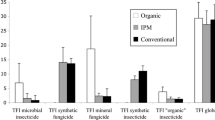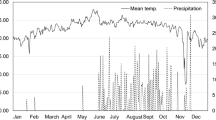Abstract
During a two year survey, a total of 3,054 spiders represented by 21 families were sampled in an unsprayed citrus orchard in the Transvaal Lowveld. Numerically the Salticidae was the dominant family (34.4%) followed by the Theridiidae (21.9%), Thomisidae (11.9%), Araneidae (7.9%), Clubionidae (7.0%) and the Tetragnathidae (3.7%). Eighteen species of spiders were observed to prey on citrus psylla,Trioza erytreae (Del Guercio) (Hemiptera: Triozidae), while six species trap nymphs and adults under their retreats and webs. There were significant positive correlations between the weekly psylla populations and the weekly populations of web-building spiders and wandering spiders present one to four weeks later but no significant correlation between the weekly spider populations and the weekly psylla populations present one to five weeks later. This seems to indicate that while spiders are unable to keep citrus psylla populations at acceptable low levels, they may contribute in reducing their numbers.
Résumé
Une étude effectuée sur 2 années dans un verger de Citrus non traité du Lowveld Transvaal a permis de répertorier 3054 araignées appartenant à 21 familles. Sur le plan numérique, la famille la plus importante était celle des Salticidae (34,2%), suivie par les Theridiidae (22,5%), les Thomisidae (11,7%), les Araneidae (8,1%), les Clubionidae (6,9%) et les Tetragnathidae (3,6%).
On a observé une prédation sur le Psylle du Citrus,Trioza erythreae, chez 18 espèces d'araignées alors que 6 espèces capturaient les nymphes et les adultes dans leurs retraites et dans leurs toiles. Il y avait des corrélations positives significatives entre les populations hebdomadaires du psylle et les populations hebdomadaires d'araignées qui tissent des toiles ou qui chassent en se déplaçant, présentes 1 à 4 semaines plus tard. Par contre, il n'a pas été trouvé une corrélation significative entre les populations hebdomadaires d'araignées et les populations hebdomadaires de psylles présentes 1 à 5 semaines plus tard.
Ces résultats semblent indiquer que si les araignées sont incapables de maintenir les populations de psylles des Citrus à des niveaux acceptables, elles contribuent toutefois à réduire leur nombre.
Similar content being viewed by others
References
Bedford, E. C. G. — 1978. Methods of controlling citrus pests. In E. C. G. Bedford (Editor), Citrus pests in the Republic of South Africa.Science Bulletin, 391,Department of Agricultural Technical Services, Republic of South Africa, p. 11–16.
Carroll, D. P. — 1980. Biological notes on the spiders of some citrus growes in central and Southern California.Entomol. News, 91, 147–154.
Catling, H. D. — 1970. The bionomics of the South African citrus psyllaTrioza erytreae (Del Guercio) (Homoptera: Psyllidae) 4. The influence of predators.J. Entomol. Soc. S. Afr., 34, 381–391.
Catling, H. D. &Annecke, D. P. — 1968. Ecology of citrus psylla in the Letaba district of Northern Transvaal.S. Afr. Citrus J. 410, 8–11, 14, 15 & 17.
Fox, R. C. &Griffith, K. H. — 1976. Predation of pine cinaran aphids by spiders.J. Georgia Entomol. Soc., 11: 241–243.
Lawrence, R. E. — 1964. A conspectus of South African spiders.Science Bulletin 369, Department of Agriculture.Republic of South Africa, 64 p.
Mansour, Fadel, Ross, J. W., Edwards, G. B., Whitcomb, W. H. &Richman, D. B. —1982. Spiders of Florida citrus groves.Fla Entomol., 65, 514–522.
Mansour, Fadel &Whitecomb, W. H. — 1986. The spiders of a citrus grove in Israel and their role as biocontrol agents ofCeroplastes floridensis (Homoptera: Coccidae).Entomophaga, 31: 269–276.
McClean, A. P. D. &Oberholzer, P. C. J. — 1965. Citrus psylla, a vector of the greening disease of sweet orange.S. Afr. J. Agric. Sci., 8, 297–298.
Riechert, Susan, E. &Lockley, T. — 1984. Spiders as biological control agents.Ann. Rev. Entomol. 29, 299–320.
Shulov, A. — 1938. Observations on citrus spiders.Hardar, 11, 206–208.
Van den Berg, M. A., Deacon, Valerie E., Fourie, Cora J. &Anderson Susan H. — 1987a. Predators of the citrus psylla,Trioza erytreae (Hemiptera: Triozidae), in the Lowveld and Rustenburg areas of Transvaal.Phytophylactica, 19, 285–289.
Van den Berg, M. A., Van Vuuren, S. P. &Deacon, Valerie E. — 1987b Cross-breeding and greening disease transmission of different populations of the citrus psyllaTrioza erytreae (Hemiptera: Triozidae).Phytophylactica, 19, 353–354.
Van der Merwe, C. P. — 1923. The citrus psylla (Trioza merwei, Pettey).Reprint no 41.Department of Agriculture.Union of South Africa, 8 pp.
Author information
Authors and Affiliations
Rights and permissions
About this article
Cite this article
van den Berg, M.A., Dippenaar-Shoeman, A.S., Deacon, V.E. et al. Interactions between citrus psylla,Trioza erytreae (Hem. Triozidae), and spiders in an unsprayed citrus orchard in the transvaal lowveld. Entomophaga 37, 599–608 (1992). https://doi.org/10.1007/BF02372330
Received:
Accepted:
Issue Date:
DOI: https://doi.org/10.1007/BF02372330




